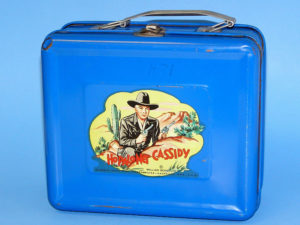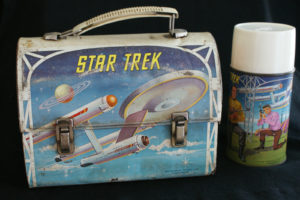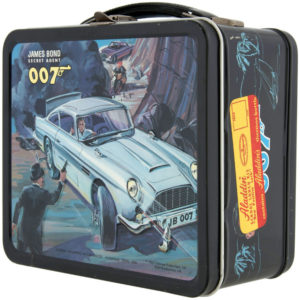
Man has been eating lunch since time immemorial. And you might think that the portable lunchbox like you carried to school in the 50’s, 60’s, or 70’s would have been just as ancient. But you would be wrong.
In 1950, Nashville, TN-based Alladin came up with a concept that they felt just might have potential, especially in light of the fact that the largest generation of six-year-olds in history were about to enter school for the first time: a metal box/vacuum bottle combination just the right size for a kid to carry his/her lunch to school in. And seeing how metal lasted forever, and a steady supply of new customers was needed in order to do future business, what if they put a TV character’s image on the box and bottle? That way, new TV shows would create demand for new lunch boxes!
I couldn’t find any names connected with that idea, but rest assured, even Don Draper has never possessed that kind of genius.
Those original Hopalong Cassidy lunchboxes were an immediate smash success, and a tradition was born for not just Boomers, but all kids of the 20th century: a perfect-sized case that a kid would proudly lug to school and back, festooned with colorful pictures.
The metal lunch box for kids was actually born in 1935, a company called Geuder, Paeschke and Frey creating a lithographed box with Mickey mouse’s image on it. But it took postwar prosperity, TV, and the addition of a Thermos bottle for the concept to become a craze.
OK, not an actual “Thermos” bottle, but that’s what the ubiquitous containers have come to be generically called. In fact, it was Thermos who decided to jump into the lunchbox fray in 1953 with their own Roy Rogers version. And it, too, was a staggering success, the kid-sized lunchbox kit increasing the company’s overall sales revenue by 20% that year.

The companies didn’t waste any time getting more TV and movie characters onto the store shelves. And more manufacturers jumped into the lucrative market. By the late 50’s, there were ten or so different brands of lunch boxes. One of these was Ohio Art, who used lunchbox profits to develop a new toy: the Etch-a-Sketch. I am astounded to realize that I have not yet written a piece on the artistic toy, stand by for that one.
It was brilliance beyond brilliance. Besides filling a utilititarian need, new TV shows came out every fall, so there would be a continuing demand for more and more lunchboxes. Life was good.
The thing is that they were built to last forever. The quality of the metal kept getting better and better. By 1962, designs were embossed onto the boxes, replacing the flat graphics. The Thermos bottles didn’t fare so well, though. The first thing to go was the plastic cap, frequently left on the table in the cafeteria. Next, the bottle itself would fall victim to gravity, and dropping a loaded box might cause the bottle’s glass liner to shatter. However, the box itself would soldier on, eventually being sold at a yard sale, or perhaps being tossed into an attic, to be rediscovered and put on eBay in the next century

An alternative to the rectangular models came along a bit later. It mimicked the classic lunchboxes that our fathers lugged to work twenty years earlier. The kid’s model originated, once again, with Aladdin, in 1957. It was expensive paying for the rights to use TV and movie characters, so Alladin decided to make miniature versions of the blue-collar’s model, decorated with more generic (and cheaper) graphics. A Disney schoolbus model was the single largest-selling lunchbox of all time, some nine million units! Other dome-tops bore the likenesses of VW buses. Additionally, many were decorated with pirates, spaceships, cowboys, and other inexpensive kid magnets.
Lunchboxes reigned supreme throughout the 60’s. The glass vacuum bottle was replaced during that decade with a plastic foam-insulated version that was more durable. But that was the last plastic improvement.
As the 70’s started rolling along, overprotective mothers became concerned that their kids were carrying potential weapons to school. Lawsuits began to be filed, wussy legislators jumped on the bandwagon of the dangers of evil metal, and the manufacturers began feeling the heat. Starting in 1972, plastic and vinyl lunchboxes became the norm, and they were, in a word, crap.
The plastic would fade and crack, the vinyl would tear, but oh, how lucky we were to be protected from that vile steel. The popularity of the school lunchbox began to fade.
Alladin continued to make a limited amount of metal boxes, the last one celebrating Rambo in 1985. In 1998, they got out of the lunchbox business altogether. Thermos continues to make them, though, even metal ones! However, they must be careful marketing them, because obviously, one of the most horrible hazards a kid can face is being plunked in the head by a fellow student possessing that most heinous weapon of mass destruction, the metal lunch box.